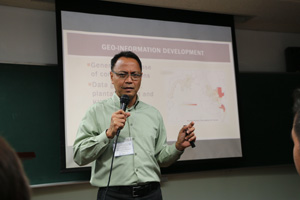
The College of Forestry and Natural Resources of UPLB (CFNR-UPLB) implemented the project, “GIS-based inventory and sustainability assessment for rubber and cacao in major production areas of the Philippines.” The project was led by Dr. Nathaniel Bantayan, Director and Park Manager of the Makiling Center for Mountain Ecosystem, CFNR-UPLB. DOST-PCAARRD funded the project through the Grants-in-Aid (GIA) program.
A national database on the locations of cacao and rubber plantations and production was developed under the project. Locations identified in the project include Agusan del Sur, Basilan, Bukidnon, North Cotabato, Compostela Valley, Davao del Sur, Davao Oriental, Palawan, and Zamboanga Sibugay. The database will also be useful in identifying possible expansion areas.
Once fully operational, the database will be downloaded to local government units, particularly to its Provincial and Municipal Agriculture Office, Provincial and Municipal Environment and Natural Resources Office, and the Department of Trade and Industry Provincial and Municipal Office.
Aside from generating a database of locations of rubber and cacao plantations in major production areas, the project also gathered information about the plantations and their attributes as well as important parameters for habitat suitability and niche modeling. Marked as possible expansion areas in the database include information on elevation, slope, mean/max temperature, annual precipitation, soil texture, and land cover.
According to the results of the project, there is an increasing trend and interest in rubber and cacao planting in regions IV-A and Region II. The results also showed that provinces may exhibit moderate or low potential as expansion area but with proper management, plantations can give profitable harvest.
At present, the largest recorded production of rubber is 127,188.53 in North Cotabato, followed by Zamboanga Sibugay at 78,093.62 metric tons. The largest production of cacao, on the other hand, is recorded at Compostela Valley at 7,548.06 metric tons, followed by Davao City, with 2,680.88 metric tons.
This topic was discussed in a forum held at the Philippine Trade and Training Center in Pasay City on the occasion of the 2017 National Science and Technology Week (NSTW). The forum is part of the showcasing of the latest and most innovative products, know-how, and services, developed and funded by the Department of Science and Technology and its agencies.
Guided by the goal of creating a venue for interaction among researchers, scientists and innovators and the industry representatives, entrepreneurs, practicing professionals, educators, among other stakeholders, the 2017 NSTW adopts the theme “Science for the People.”
